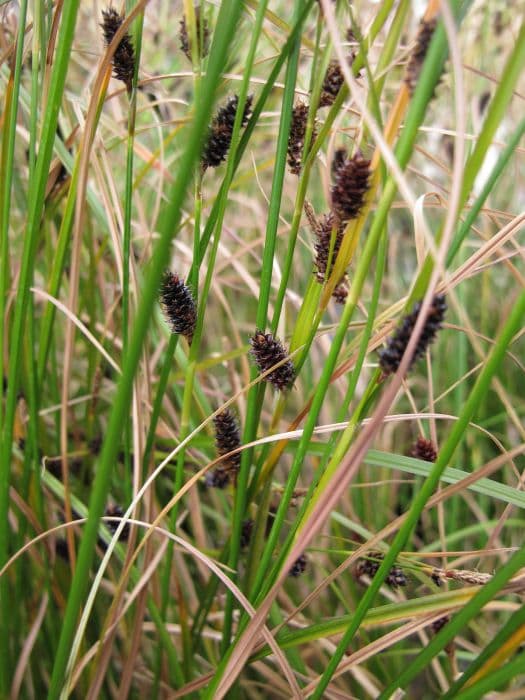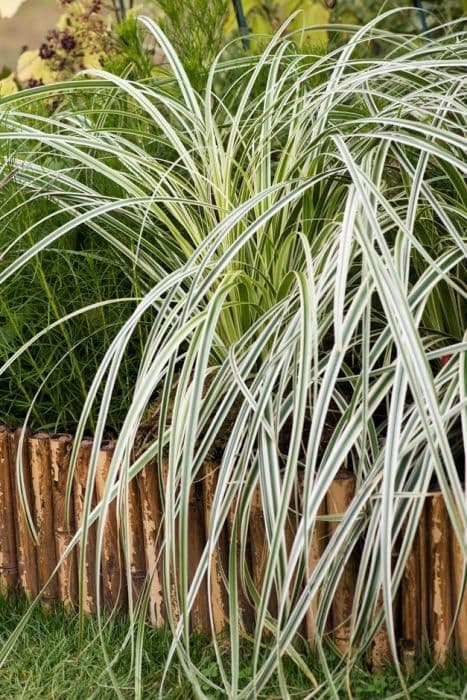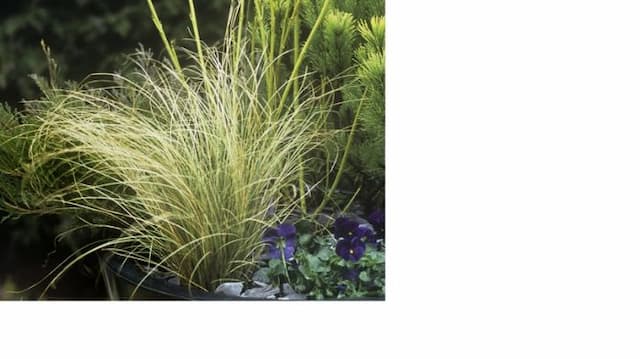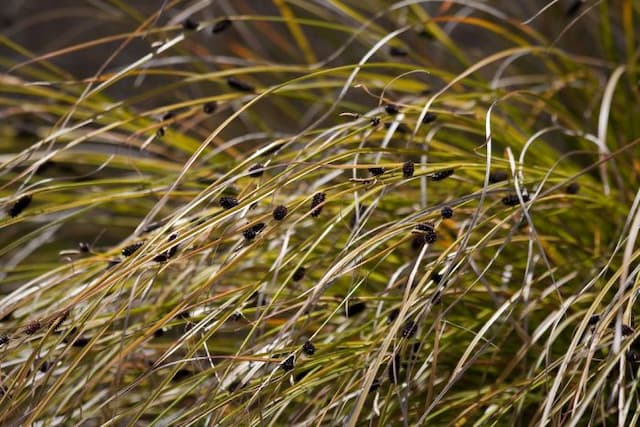Variegated Broadleaf Sedge Carex siderosticta 'Variegata' (v)

ABOUT
The plant known as Carex siderosticta 'Variegata', commonly referred to as variegated sedge, is notable for its striking, ornamental foliage. The leaves of this plant are long and narrow, creating a graceful, arching effect that adds softness to the garden. Each leaf is edged with a creamy-white border that contrasts beautifully against the green center, giving the plant a bright and variegated appearance. This variegation can add light to shadier spots in a garden and create a sense of depth and dimension. The texture of variegated sedge's leaves is fine, adding a delicate touch to the landscape. It has a dense, clump-forming habit with the leaves emerging from the base and creating a tufted look. This plant can act as a lovely groundcover, its foliage spreading out to create a continuous carpet of variegated green and white. The leaves may gently weep at the tips, which further enhances the plant's graceful silhouette. During the growing season, variegated sedge may also produce inconspicuous, small flower spikes that are more appreciated for their contribution to the plant's texture than their color. These flowers generally blend into the foliage, ensuring that the leaves remain the true stars of the show. Variegated sedge can bring a fresh and vibrant look to gardens or containers, with its variegated leaves providing a striking visual interest and making it a popular choice for both gardeners and landscape designers. Its visual appeal lies in the pattern and contrast of its foliage rather than the size or scale of the plant itself.
About this plant
 Names
NamesSynonyms
Variegated Broad-leaved Sedge, Variegated Carex, Variegated Hime-Kan-Suge.
Common names
Carex siderosticta 'Variegata'.
 Toxicity
ToxicityTo humans
Variegated sedge (Carex siderosticta 'Variegata') is not commonly known to be toxic to humans. If ingested, it is unlikely to cause poisoning or severe adverse effects. However, as with many plants, individual sensitivities or allergic reactions could occur from handling or ingesting the plant.
To pets
Variegated sedge is not commonly known to be toxic to pets. It is generally considered safe for animals, and if ingested, it is unlikely to cause poisoning or severe adverse effects in pets. As always, monitoring pets for any signs of allergic reactions or gastrointestinal upset is advisable after ingesting any plant matter.
 Characteristics
CharacteristicsLife cycle
Perennials
Foliage type
Evergreen
Color of leaves
Variegated
Height
1 feet 4 inches (40 cm)
Spread
1 feet 8 inches (50 cm)
Plant type
Herb
Hardiness zones
5
Native area
Asia
Benefits
 General Benefits
General Benefits- Visual interest: The variegated foliage of Carex siderosticta 'Variegata' adds a striking visual contrast to garden settings with its green and white striped leaves.
- Low maintenance: This sedge requires minimal care once established, making it a convenient choice for gardeners of all levels.
- Soil erosion control: With its dense growth habit, it can help to stabilize soil and prevent erosion in garden beds or on slopes.
- Habitat for wildlife: The plant can provide shelter and breeding grounds for small garden wildlife like insects and birds.
- Tolerance of various conditions: It is adaptable to a range of soil types and can tolerate both moist and dry conditions, as well as partial shade.
 Medical Properties
Medical PropertiesThis plant is not used for medical purposes.
 Air-purifying Qualities
Air-purifying QualitiesThis plant is not specifically known for air purifying qualities.
 Other Uses
Other Uses- Container Gardening: Carex siderosticta 'Variegata' can be used in container gardening to create visually appealing arrangements. Its striking foliage can add contrast and texture to mixed planters.
- Accent Plant: Due to its variegated leaves, this sedge can serve as an accent plant in garden designs, drawing attention to specific areas with its bright foliage.
- Groundcover: When planted in masses, the 'Variegata' can effectively act as a groundcover, reducing weed growth and covering bare spots in the landscape.
- Erosion Control: The dense root system of this plant can help stabilize soil on slopes and prevent erosion, especially in shady areas where other plants might struggle to grow.
- Water Garden Edges: This sedge can be utilized along the edges of water gardens or ponds to provide a naturalized look and soft transition from water to land.
- Winter Interest: With evergreen leaves in climates with milder winters, it can provide visual interest to an otherwise barren winter garden landscape.
- Borders: Carex siderosticta 'Variegata' can be used as a border plant to define garden paths or separate different sections of a garden owing to its neat clumping habit.
- Wildlife Habitat: The sedge can offer habitat and shelter for small wildlife, as birds may use the foliage for nesting materials.
- Edge Accents for Walkways: Planted alongside walkways, the plant's foliage can soften hard edges and provide a pleasing aesthetic as one walks through a garden.
- Artistic Inspirations: Gardeners and artists may use the strikingly patterned leaves as inspiration in various forms of art, including painting and textile designs.
Interesting Facts
 Feng Shui
Feng ShuiThe Variegated sedge is not used in Feng Shui practice.
 Zodiac Sign Compitability
Zodiac Sign CompitabilityThe Variegated sedge is not used in astrology practice.
 Plant Symbolism
Plant Symbolism- Versatility: The 'Variegata' cultivar of Carex siderosticta displays variegated foliage, indicating flexibility and the ability to adapt to various circumstances, just as the plant can thrive in different light conditions.
- Boundedness: As a sedge, this plant often forms a dense mat of foliage, symbolizing interconnectedness and the importance of staying grounded.
- Harmony: The balanced variegation pattern on the leaves suggests equilibrium and aesthetic harmony in its design, reflecting the plant's ability to bring visual peace to garden spaces.
- Purity: The clean white markings along the leaves can symbolize purity and innocence, much like how white is often associated with these qualities in various cultures.
 Water
WaterVariegated Sedge prefers consistently moist soil and should be watered once the top inch of soil begins to dry out. This might mean watering approximately every 5 to 7 days, but this can vary depending on environmental factors such as temperature and humidity. Generally, applying 1 to 2 gallons of water per week should be sufficient to maintain soil moisture, but make sure not to overwater as this can lead to root rot. During the winter months, reduce watering frequency as the plant enters a period of dormancy.
 Light
LightVariegated Sedge thrives best in partial shade to full shade conditions. It prefers a spot where it can be sheltered from the intense midday sun, which can scorch its leaves. The ideal location would offer bright indirect light or dappled sunlight, such as at the edge of a tree canopy or under a high shade structure.
 Temperature
TemperatureVariegated Sedge is hardy and can tolerate a range of temperatures, with ideal growth occurring between 50°F and 70°F. It can survive minimum temperatures down to around 30°F but should be protected from freezing weather. The plant can also endure high temperatures up to about 80°F, as long as it is not in direct sunlight and has sufficient moisture.
 Pruning
PruningPruning Variegated Sedge is mainly done to remove old, brown, or damaged foliage and to maintain plant shape. It is best to prune in the early spring before new growth begins. Cut back foliage to about 3 to 4 inches from the ground to encourage fresh, new growth. Pruning may also be done occasionally throughout the growing season to remove any unsightly leaves.
 Cleaning
CleaningAs needed
 Soil
SoilThe best soil mix for Variegated Broadleaf Sedge should be well-draining and rich in organic matter, with a slightly acidic to neutral pH of 6.0 to 7.0. A mix of garden soil, peat, and sand or perlite would be ideal for this sedge.
 Repotting
RepottingVariegated Broadleaf Sedge should be repotted every 2 to 3 years to refresh the soil and to accommodate the growth of its spreading rhizomes.
 Humidity & Misting
Humidity & MistingVariegated Broadleaf Sedge thrives in average to high humidity levels, mirroring its natural damp and boggy habitat. Aim for humidity levels above 50% for optimal growth.
 Suitable locations
Suitable locationsIndoor
Place in bright, indirect light with high humidity.
Outdoor
Plant in moist soil, partial shade area.
Hardiness zone
5-9 USDA.
 Life cycle
Life cycleThe life of Variegated Broadleaf Sedge (Carex siderosticta 'Variegata') begins with seed germination, typically occurring in the spring as the soil warms. The seeds develop into small seedlings that establish a root system and send up shoots. As the plants mature, they form dense tufts of variegated foliage – green leaves striped with white – that are evergreen in milder climates but may die back in colder regions. Flowering occurs in late spring or early summer, producing inconspicuous brown or green flowers that rarely catch the eye. The plant spreads through rhizomes, creating a wider clump over time, and may also produce seeds that can disperse to form new plants. Periodically, older clumps can be divided in early spring or fall to rejuvenate the plant and encourage more vigorous growth.
 Propogation
PropogationPropogation time
Spring-early summer
Propogation: The most popular method of propagating the Variegated Siberian Sedge (Carex siderosticta 'Variegata') involves division, which is best done in the spring as the plant emerges from its winter dormancy. To propagate by division, carefully dig up the plant, making sure to maintain a good amount of soil around the roots to minimize shock. Gently separate the plant into smaller sections, each with a piece of the crown and several healthy roots. Dividing the plant into sections that are about 4 inches (approximately 10 centimeters) in size is typically manageable. After division, immediately replant the sections at the same depth they were previously growing and water them well to help establish the new divisions. Over the following weeks, keep the soil consistently moist to support the newly propagated plants as they take root in their new locations.









